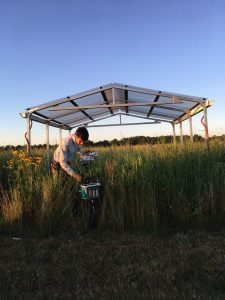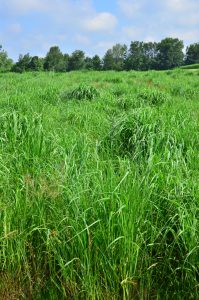Michigan State University researchers have solved a puzzle that could help switchgrass realize its full potential as a low-cost, sustainable biofuel crop and curb our dependence on fossil fuels, in part through research conducted at the the W.K. Kellogg Biological Station.
Among switchgrass’s attractive features are that it’s perennial, low maintenance and native to many states in the eastern U.S., including Michigan. But it also has a peculiar behavior working against it that has stymied researchers — at least until now.
‘Okay, we’re done’
Berkley Walker’s team in MSU’s Department of Plant Biology has revealed why switchgrass stops performing photosynthesis in the middle of the summer — its growing season — limiting how much biofuel it yields.
This knowledge, published in the journal Frontiers in Plant Science, is a key piece to overcoming this quirk and getting the most out of switchgrass.
“The plants get to about midseason and say, ‘Okay, we’re done,’” said Walker.
“As a researcher, you’re literally asking, ‘Why are you doing that? It’s warm, the sun is out and your leaves are green. What is happening?’” said Mauricio Tejera-Nieves, a postdoctoral researcher and the lead author of the team’s study.
Tejera-Nieves joined Walker’s team with a hypothesis to answer that, as well as the means to test it with support from the Great Lakes Bioenergy Research Center, or GLBRC. He suspected that a lack of water might be playing a role.
In addition to awarding Tejera-Nieves a fellowship, the GLBRC had built what are called rainfall exclusion shelters in the fields at Kellogg Biological Station. These do exactly what their name promises: They exclude rain. Plants underneath the shelters stay dry while their neighbors outside can freely soak up sprinkles, showers and storms.
The shelters presented the perfect place to test Tejera-Nieves’ idea, even if it didn’t go exactly as he initially predicted.
“If water limitation was the reason for the behavior, the plants under the shelters would do poorly,” Tejera-Nieves said. “But they didn’t. After six months of water limitation, the plants under the shelter were just as happy as the plants outside.”
Digging deeper
So, he needed to dig a little deeper — literally — to look at what was happening in the rhizomes. He found that the starch levels of all the plants grew over time until they hit a peak level and then would remain flat. Once that happened, photosynthesis in the plants’ leaves switched off.
“Once the rhizomes are full, the plant just stops,” Tejera-Nieves said.
Tejera-Nieves, Walker and their colleagues discovered the explanation for this limitation in switchgrass’s rhizomes. These are little knobby structures that live underground among the plant’s roots. If you’ve ever sliced or shredded ginger, you’ve held a rhizome.
Rhizomes store food in the form of starch to help plants survive winter, and that starch is made from the sugars produced by photosynthesis. Once switchgrass rhizomes are full of starch, they signal the plant to stop making sugars and adding biomass through photosynthesis.
Tejera-Nieves compared the rhizomes to a bank, albeit a slightly unusual one.
“Imagine getting a call from your bank and they tell you, ‘Hey, your account is full. You can take a vacation, go on sabbatical, do whatever you want. Just stop working because we’re not storing any more money,’” Tejera-Nieves said. “It’s a very conservative strategy, but it’s one that works for switchgrass. The longer it’s doing photosynthesis in nature, the more likely it is that an animal will eat it or something else bad will happen.”
Although this evolutionary strategy has worked to the plant’s advantage in nature, it is a disadvantage for humans who want to ferment switchgrass’s biomass into biofuel. By understanding the root cause of this behavior, though, researchers can start looking for ways around it.
“Now we can start looking for breeding solutions,” said Walker. “We can start looking for plants that have an insatiable appetite for photosynthesis.”
Related articles
Mystery solved: Why switchgrass takes the summer off | Jan. 30, 2023
The next biofuel? MSU researchers focus on switchgrass and ethanol potential | Jan. 31, 2023




A legacy of conservation; a commitment to sustainability.
3700 E. Gull Lake Drive
Hickory Corners, MI 49060
(269) 671-5117
info@kbs.msu.edu